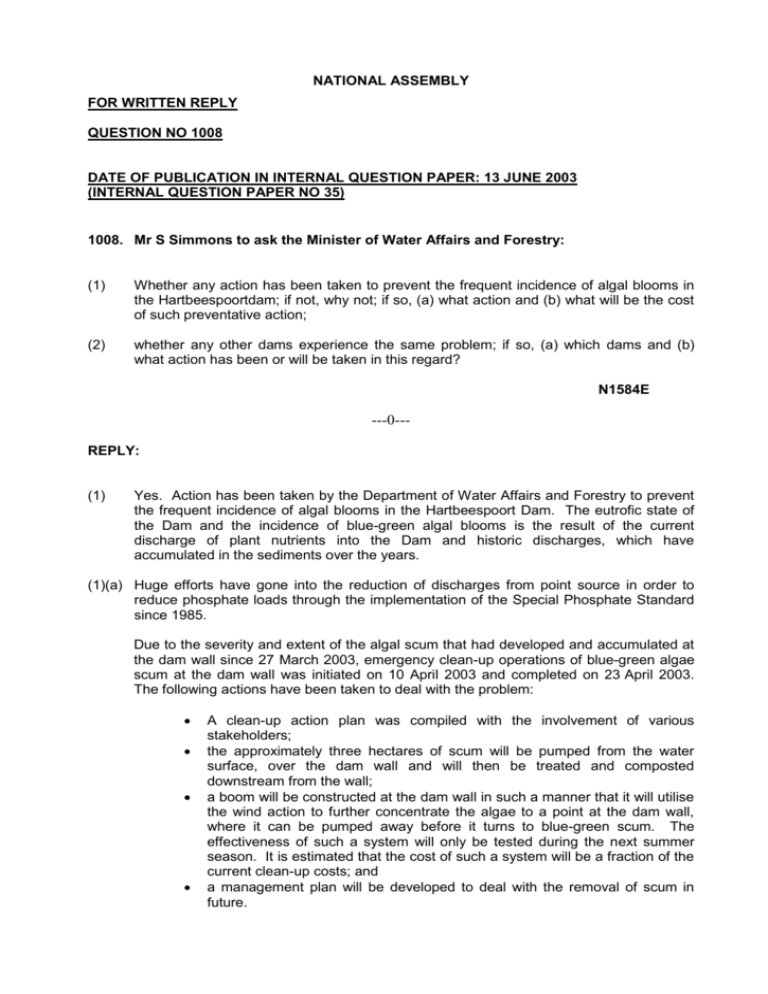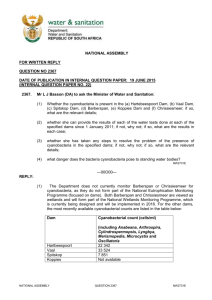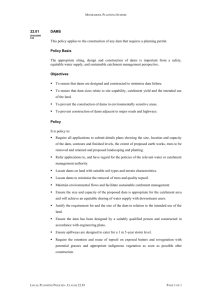NATIONAL ASSEMBLY - Department of Water Affairs
advertisement

NATIONAL ASSEMBLY FOR WRITTEN REPLY QUESTION NO 1008 DATE OF PUBLICATION IN INTERNAL QUESTION PAPER: 13 JUNE 2003 (INTERNAL QUESTION PAPER NO 35) 1008. Mr S Simmons to ask the Minister of Water Affairs and Forestry: (1) Whether any action has been taken to prevent the frequent incidence of algal blooms in the Hartbeespoortdam; if not, why not; if so, (a) what action and (b) what will be the cost of such preventative action; (2) whether any other dams experience the same problem; if so, (a) which dams and (b) what action has been or will be taken in this regard? N1584E ---0--REPLY: (1) Yes. Action has been taken by the Department of Water Affairs and Forestry to prevent the frequent incidence of algal blooms in the Hartbeespoort Dam. The eutrofic state of the Dam and the incidence of blue-green algal blooms is the result of the current discharge of plant nutrients into the Dam and historic discharges, which have accumulated in the sediments over the years. (1)(a) Huge efforts have gone into the reduction of discharges from point source in order to reduce phosphate loads through the implementation of the Special Phosphate Standard since 1985. Due to the severity and extent of the algal scum that had developed and accumulated at the dam wall since 27 March 2003, emergency clean-up operations of blue-green algae scum at the dam wall was initiated on 10 April 2003 and completed on 23 April 2003. The following actions have been taken to deal with the problem: A clean-up action plan was compiled with the involvement of various stakeholders; the approximately three hectares of scum will be pumped from the water surface, over the dam wall and will then be treated and composted downstream from the wall; a boom will be constructed at the dam wall in such a manner that it will utilise the wind action to further concentrate the algae to a point at the dam wall, where it can be pumped away before it turns to blue-green scum. The effectiveness of such a system will only be tested during the next summer season. It is estimated that the cost of such a system will be a fraction of the current clean-up costs; and a management plan will be developed to deal with the removal of scum in future. -2- (1)(b) The project cost to date is R520 635,00, which includes the development of a management plan on how to deal with future algae scum in the most appropriate and cost effective way. The cost to manoeuvre the scum towards the suction point at the dam wall constitutes the largest portion of the clean-up operation. The total cost to manage the removal of scum in a co-ordinated way for the entire dam is estimated between one and R1 million and R2 million per annum. These costs are necessary to keep the dam in a tolerable state until such time as the rehabilitation plan is implemented (treatment of phosphate and improve bio-diversity) and the ecological balance of the dam is restored. With regard to the cost of preventative action, I can add that an amount of R2 million was made available by the North West Provincial Government while an amount of just over R300 000 will be made available on an annual basis by the Madibeng Local Council for the Kwena Forum. (2)(a) Yes. Microcystis blooms and the periodic appearance of blue-green algae scum have occurred for more than 30 years in various eutrofic water resources of our country. Apart from the Hartbeespoort Dam, toxic cyanobacterial events have been recorded at the following dams in South Africa - this is an indication that serious cyanobacterial blooms have occurred: Albert Falls Allemanskraal Bloemhof Bon Accord Bospoort Bridle Drift Bronkhorstspruit Erfenis Grootdraai Hazelmere Inanda Klein Maricopoort Klipdrif Klipvoor Koppies Laing Lake Arthur Nagle Nahoon Rietkuil Rietvlei Roodeplaat Saulspoort Spioenkop Spitskop Stinkpan Theewaterskloof Vaal Vaal Barrage Van Ryneveldspas Vanderkloof Volksrus Witbank Zoo Lake Microcystis (the cyanobacterial species that is causing most of the toxic incidents in South Africa) have been found to be occasionally dominant at the following dams in South Africa: Albert Falls Allemanskraal Bloemhof Boegoeberg Bon Accord Boskop Bospoort Bridledrift Bronkhorstspruit Cook's Lake Disaneng EJ Smith Loskop Lotlamoreng Magoebaskloof Middelburg Midmar Nahoon Nungwane Rietvlei Roodekopjes Roodeplaat Setumo Shongweni -3- Erfenis Gariep Grootdraai Hartbeespoort Henkries Inanda Klein Maricopoort Klipdrif Klipfontein Klipvoor Koppies Kosterrivier Laing Lindleyspoort (2)(b) Spioenkop Spitskop Sterkfontein Taung Theewaterskloof Twee Rivieren Tzaneen Vaal Vaalgamagara Vaalhartz Vaalkop Voelvlei Volgraafsig Witbank My Department is applying strict licence conditions in respect of developments around all the major dams in South Africa in an effort to be proactive. The relationship between my Department and other spheres of government has to be formalised to enable my Department’s regional offices to put proactive procedures in place in order to deal with similar future incidences of algae blooms. This will not only be more cost effective, but will ensure the proper involvement and engagement of all stakeholders. I can mention that one such initiative is the newly established joint venture between the Rustenburg Local Council, Magalies Water, Anglo Platinum Mines and financial institutions that has as an objective improved water management at water care works. All the abovementioned dams that suffered from algal blooms had one common denominator, i.e. return flow from treatment works. The high nutrient concentrations in the return flows contributed detrimentally to the status of the water quality of the affected dams. In this particular instance the Joint Venture will ensure that all treated water will be recycled to the mines in the Rustenburg area. The funds generated from the water sales will be utilised to upgrade and improve the Rustenburg Sewerage Treatment Works in order to alleviate the eutrophication problem at the Boschpoort Dam.









